Best Fertilizer (Plant Food) For Pine Trees
Pine trees prefer a balanced fertilizer with NPK 20-20-20. This implies that the fertilizer must have a balanced composition of nitrogen, phosphorus, and potassium.
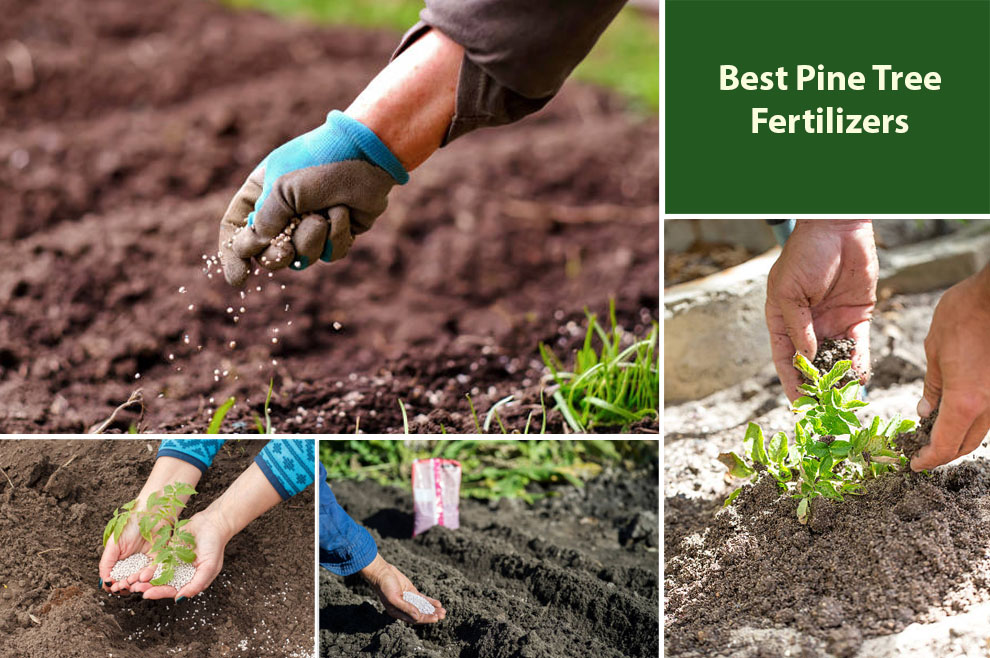
Pine is a beautiful evergreen conifer that can thrive in several conditions and climates. They are green and shiny around the year. Its seeds form uniquely, but not from the flowers. Instead, they grow from the woody cones, symbolic of winter.
It is a tall plant with varying widths and usually grows up to 260 feet. Anyone who aspires to preserve and grow evergreen trees like pine must invest in one of the best fertilizers for pine trees.
It might slow its growth if you do not feed your plant the necessary nutrients. Consequently, the plant will not be as perky or vibrant as it usually is. Of course, you can craft your organic compost, but fertilizers go the extra mile and endow your plant with a steady growth rate.
However, with umpteen brands available, which is the most suitable pine tree fertilizer? Pine trees are self-sustaining. Hence, they are not heavy feeders. If you water them well, they will grow wonderfully.
Ideally, a well-balanced 20-20-20 NPK feed in infertile soil can do wonders for the plant. To promote future growth and health, you must feed the plants while they are still young.
But, even mature pines can benefit from a recommended fertilizer dosage. So, which are the top feed choices for pine trees? Here are some options.
Best Fertilizers For Pine Trees
- Best Slow-Release Spikes – Jobe’s Fertilizer Spikes
- Natural Pick – Shake ‘N Feed Flowering Trees and Shrubs Plant Food
- Ideal for Pest Protection for Up To One Year – BioAdvanced Tree and Shrub Protect and Feed
- Best Easy to Use Continuous Release – Scotts Evergreen, Flowering Tree & Shrub Plant Food
- Natural Fertilizer for Acid Loving Trees – Espoma Organic Holly-tone 4-3-4 Natural & Organic Evergreen & Azalea Plant Food
- Specialized Pine Tree Fertilizer – TreeHelp Premium Fertilizer for Pine
Not every fertilizer will work for your pine tree varieties. While some may suit the deciduous trees, others are meant solely for the evergreens. So, the easiest way to determine the best pine fertilizer is by performing a soil assessment. It will confirm whether your plant needs fertilizing while determining the nutrients your soil lacks.
Typically, a slow-release fertilizer works best for the pines. You must evenly distribute your chosen fertilizer, ensuring the soil gets the necessary nutrients.
In addition, it must go straight to the roots for the plant to absorb all the good stuff. Here are some of our top recommendations.
1. Jobe’s Fertilizer Spikes, Evergreen Tree, 15 Count, Slow Release, Cypress, Juniper, Magnolia
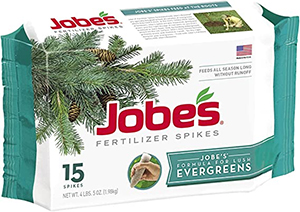 |
Check price on Amazon |
Need a fertilizer that can deliver the necessary nourishment to the roots without you worrying too much about the right quantity? This Jobe’s pine tree fertilizer can be a good pick.
It will provide the plants with a good dose of nutrients. Backed by a slow-release formula, its spikes can help better the tree across the summer months.
It is one of the easy-to-use fertilizers with no mess, no wasteful runoff, and no smells or hazards. You can apply it in late fall and early spring.
How to use it?
This is one of the best plant food for pine trees, but before using them, water the pines thoroughly. You can place the spikes around the tree’s drip line.
The feed comes in a pre-measured formula and helps deliver the correct nutrient dosage below the surface, wherein the roots are actively growing.
So, you need to add the requisite number of spikes by determining the trees’ diameter. For instance, two spikes will work well if the diameter is about two inches. For shrubs, you can use one spike for every three feet of height.
Check price on Amazon
2. Shake ‘N Feed Flowering Trees and Shrubs Plant Food
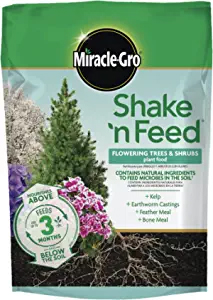 |
Check price on Amazon |
It is one of the top-recommended natural fertilizers for pine. It contains natural ingredients and vital micronutrients that feed the microbes in the soil. It contains earthworm castings, kelp, bone meal, and feather meals all-in-one that helps feed the microbes in the soil.
The microbes break down the organic matter into nutrients, which help in root development and strength and amplify water efficiency. You can use it for all acid-loving plants, shrubs, and trees.
The pine tree fertilizer can help maintain lush-green, deep foliage, and colorful blooms across the season. It is a continuous-release fertilizer that gives the plants a good start and its effect for up to three months.
You can use it both in a container and in-ground plants. It starts showing adequate results in two days only. However, the fertilizer might trigger burning if your watering schedule is not on point.
How to use it?
Depending on the tree’s size, take the recommended dosage, shake it well and pour it onto the soil within the drip line. After fertilizing, ensure that you water the tree well.
Check price on Amazon
3. BioAdvanced 12 Month Tree and Shrub Protect and Feed, Granules, 4 lb
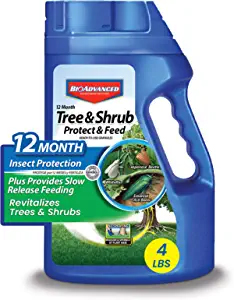 |
Check price on Amazon |
It is one of the best fertilizers for pine trees, offering the plant twelve-month protection against pests with only a single application. It kills insects like emerald ash borers, aphids, adelgids, Whiteflies, adult Japanese Beetles, and several other stated pests.
The fertilizer works well for outdoor trees, potted plants, and shrubs and guards their leaves to the stems and the roots.
Overall, this feed restores shrub and tree vitality and offers season-long nutrition. It also amplifies your plant’s health with slow-release food suitable for your shrubs and trees.
How to use it?
You can apply it every fall to guard it across the summer and spring. This feed can be employed anytime the soil is not frozen or waterlogged. However, you must read its instruction label to understand its necessary dosage.
4. Scotts Evergreen, Flowering Tree & Shrub Continuous Release Plant Food 3 lb., 2-Pack
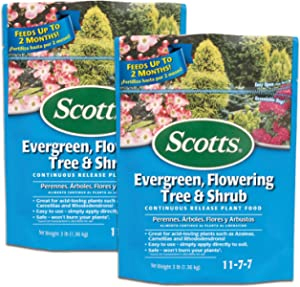 |
Check price on Amazon |
It is the best feed for pine trees, dogwoods, evergreens, magnolias, hydrangeas, and several other acid-loving shrubs and trees that lives up to their name by continually releasing nutrients into the soil.
The fertilizer fosters lush foliage and stimulates a robust root system. It is a recommended fertilizer for acid-loving plants like rhododendrons, camellias, and azaleas.
Scotts fertilizer is safe and ensures that every part of the plant receives nutrients. It will not burn your plants, provided you use it as directed on the manufacturing label. This pine tree fertilizer can feed the plant for two months.
It has a good NPK level to suit well-composed soil and can trigger fast growth in only one season. Please do not use this fertilizer for smaller pine varieties.
How to use it?
It is an easy-to-use fertilizer, and you can apply it directly to the soil. You can nourish thirty-five square feet of land with only one cup of the product.
Spread it evenly around the initial three inches to promote an even nutrient spread. Water deeply to activate the solution.
- Beneficial NPK for well-composted soil
- Fast growth in just one season
5. Espoma Organic Holly-tone 4-3-4 Natural & Organic Evergreen & Azalea Plant Food
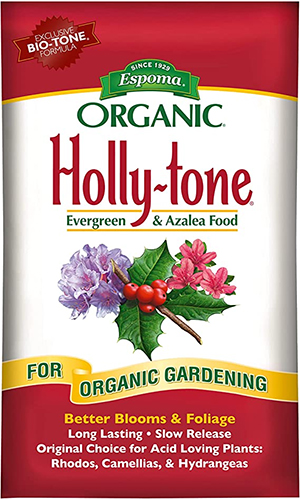 |
Check price on Amazon |
It is an original plant food for all acid-loving plants. The fertilizer’s natural organics break down slowly to offer a long-lasting reservoir of plant nutrients.
You can use this Holly-tone fertilizer for rhododendrons, hydrangeas, azaleas, strawberries, camellias, evergreens, blueberries, and all plants that love acidic soil. This plant feed contains a fine mix of organic and natural ingredients, accentuated with the exquisite Bio-tone formula.
Its 4-3-4 composition with five percent sulfur makes it one of the top-recommended pine tree fertilizers. It contains no toxic materials or sludges and is safe for the environment, and gives fast results.
The only low we find with this fertilizer is that it has an odor that the dogs may find attractive. So, keep an eye on your pets if you use this fertilizer.
How to use it?
You can use this fertilizer in the fall and spring on evergreen shrubs and flowering plants, but berry growers must use it in late and early spring. It is a ready-to-use fertilizer and demands no mixing.
You can apply 1 tsp fertilizer to the three inches of soil around the plant’s drip line and water it well. This organic fertilizer is safe for organic farming and is registered Organic Input Material, implying that it caters to all requirements necessary for organic production.
However, never exceed the manufacturer’s recommendation, as it may result in a root burn.
6. TreeHelp Premium Fertilizer for Pine
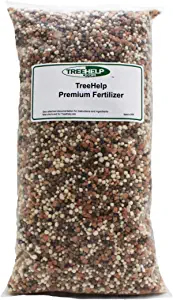 |
Check price on Amazon |
It is another effective fertilizer that can provide a suitable dose of nutrients to pines. Beyond nourishment, it also gives the needed strength to battle insect attacks and typical ailments.
It contains an excellent mix of micro and macronutrients that amplify root growth and boosts immunity. Its nitrogen releases gradually and goes feeding the pines across the growing season.
Customers who used this fertilizer claimed that it gave their plant a new color and helped them save it. This fertilizer can feed one large tree or two-three newly planted or smaller plants.
How to use it?
The manufacturer has provided complete instructions on the label. Please follow them to the T, and enjoy good produce.
Choosing The Right Pine Tree Fertilizer
If you aspire for thick and vibrant pine needles, you must be well-versed in your plant’s nutrient needs. A slow and low fertilizing approach works best for the mature conifers and provides them with all the nutrients.
Here are some tips for picking the correct fertilizer:
A. Perform a soil assessment
To pick a fertilizer with the right NPK ratio, you must understand what your conifer needs and what its current soil offers. So, perform a soil assessment and then look for the fertilizer that can make up for the deficiencies.
B. Note the pH value
Pine trees can survive at various pH levels. But, it thrives in pH between 5.5 and 6.5. Hence, pH examination is also vital, and you must pick a fertilizer with acidic content that can bring it as close to its desired value.
C. Picking between granular vs. liquid fertilizer for pine trees
Typically, pines like spike, granular, and slow-release fertilizers over the liquid options, which inundate all the nutrients in one go.
Large doses in a single go might result in over-feeding and may be fatal for the plant. But, liquid fertilizers can be advantageous when you plant your trees in less-than-fertile soil as they will immediately offer the nutrients plant needs to grow and thrive.
D. Fertilizer Spikes
They are the most convenient alternatives as they come in pre-measured doses. You can push them into loamy soil. Moreover, since they are slow-releasing, they won’t burn the foliage.
E. Organic Vs. Synthetic Fertilizers
It is a personal choice and depends primarily on your final expectations from the plant. Organic fertilizers contain nutrient levels which mimic nutrients that conifers will have access to in the wild.
They nourish the plant and amplify its fertility while increasing drainage and aeration. On the contrary, synthetic fertilizers are readily available in the market. So, if you do not have access to organic feeds, you can opt for them.
Is Mulching A Good Idea After Using Fertilizers?
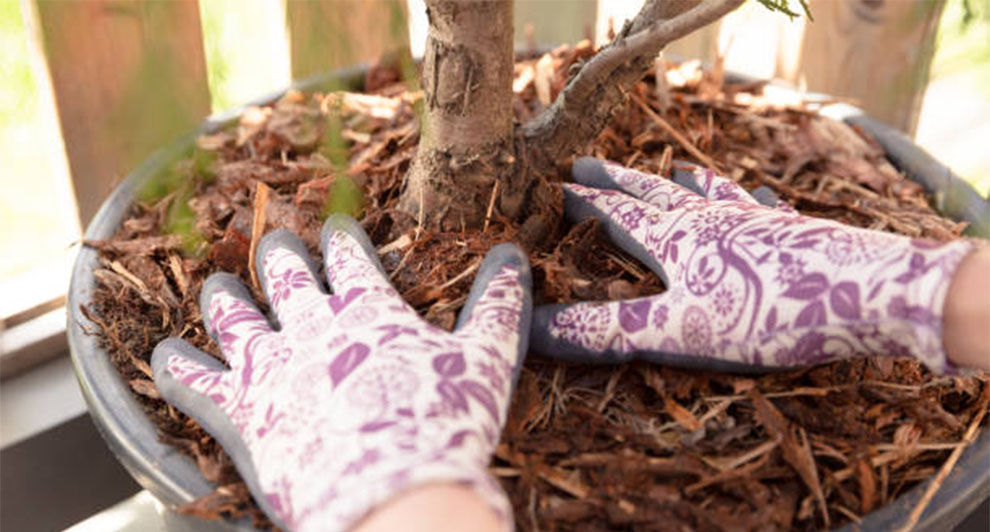
Mulch over a granular fertilizer, followed by water, can be advantageous for the plant roots. Alternatively, if the soil is totally inadequate, you can use liquid fertilizer and mulch on the foliage for excellent results.
When Should I Fertilize Pine Trees?
Even if you use the best fertilizer for pine trees but at the wrong time, it won’t do any good to your tree. So, the most suitable time for fertilizing the pine trees depends on two factors:
- Are they water-stressed?
- Which growth stage are they in?
As mentioned earlier, pines love water more than any feed, and water is crucial to their plump texture and lush produce.
For specifics, below are some situations when you must fertilize your pine trees:
- The leaves are browning and full.
- Woodpeckers and deer damaged the pine.
- It has been neglected for several years.
- You want to get it ready for the new growth – April to mid-July.
- Soil conditions, say sandy soil – Consider splitting the application and feeding once in early spring and re-fertilize in late spring.
Generally, all growing pine trees can survive without fertilizer, provided you mulch and water them well. The mulching nutrients suffice for the growing trees.
How Many Times A Year Should You Fertilize Them?
Fertilization can promote good productive success. However, conifers do not need more than necessary. So, fertilizing twice a year in the growing season suffices. If you have pines growing in your yard, they will benefit from the fertilizer applied to the lawn and will need nothing more.
Also, knowing the application method and the fertilizer brand can also determine the frequency of fertilization.
Further, clarity on the plant’s specific nutrient needs is also vital, but it mainly depends on its growth stages. Before the plant matures, the drop line application method works best for the plant and must be followed every two to four years. After maturity, the plant needs lesser fertilization.
Is There A Homemade Fertilizer For Pine Trees?
Egg shells can be an excellent homemade fertilizer. It will offer the plants a healthy dose of potassium and calcium.
Pine Tree Fertilizing Tips
- Pine trees require a combination of fish emulsion and bone meal to amplify the soil acidity and feed nutrient-deficient pine trees.
- It’s better to water first and then apply the fertilizer.
- A thick mulch layer at the trees’ feet provides an excellent nutrient source for the plant.
- Do not pour the fertilizer close to the trunk because it may burn its stem.
- You can sprinkle the crumbled fertilizer spikes around the tree and water frequently.
- A low and slow approach works best for the pines if the soil looks depleted or the plant shows stunted growth. They offer the necessary nutrients without harming the roots and the trees.
- Over-application is the root cause of fertilizer burns. Hence, you must perform a soil assessment to examine your soil and ensure that you provide your evergreens only what they need. In addition, before feeding, always take measurements to only feed the required dosage.
Related: Pine tree lifespan | Pine tree growth rate | Types of pine cones
Thinking About Natural Fertilizer for Pine Trees?
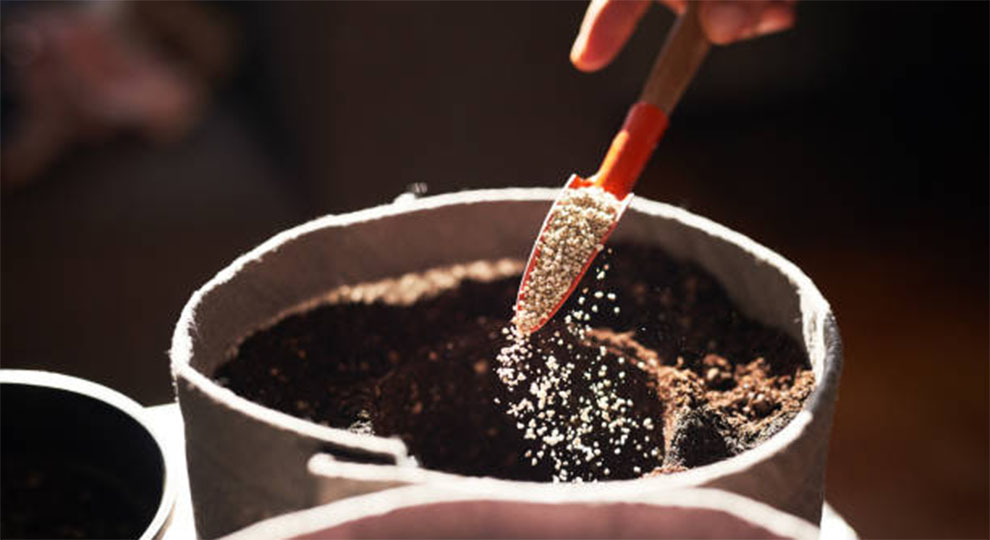
Ques 1. Can you use Cottonseed meal?
Ans. A cottonseed meal can be a good pick if you seek an organic fertilizer for your pines. It is rich in protein and slows the decomposition process. It implies the materials in cottonseed do not readily enter the plant.
They may take several months to decompose. Consequently, you will need lesser fertilizer, which will not burn your plant from excess acidity.
Ques 2. Are coffee grounds good for pine trees?
Ans. Coffee grounds are a good pick if you wish to amplify the soil’s acidity. It will give a good nitrogen dose but not make up for the plant’s potassium and phosphorous requirements. So, you will have to look for alternatives for the same.
Ques 3. Is chicken manure good for pine trees?
Ans. Chicken manure can be an excellent pick for fruit trees if employed in moderation and composted.
Ques 4. Is Epsom salt good for pine trees?
Ans. Epsom salt or magnesium sulfate is a good choice if the soil pH is too low or too high. It contains oxygen, sulfur, and magnesium, which help the plant and amplifies its ability to absorb vital nutrients.
Unlike other homemade fertilizers for pine trees, Epsom salt does not build up over time. You can use it in water-diluted or dry forms.
